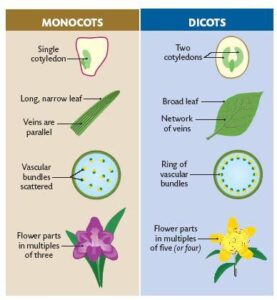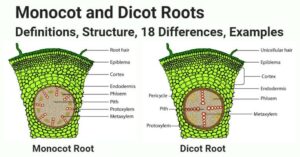Back to: Botany 300 Level
Hello, my brilliant friend! I hope you’re having a fantastic day! Have you ever looked at different plants and wondered why some trees grow thicker over time while others stay slender? This difference is linked to secondary growth, which happens differently in monocots and dicots. Today, we’ll explore the differences between monocot and dicot secondary growth and why some plants develop thick, woody stems while others do not.
Differences between monocot and dicot secondary growth
What is Secondary Growth?
Secondary growth is the process by which plants increase in girth (thickness) due to the activity of lateral meristems, mainly the vascular cambium and cork cambium. This type of growth is common in woody plants and helps them develop strong, supportive stems.

However, not all plants undergo secondary growth! This brings us to the major difference between monocots and dicots.
Secondary Growth in Dicots
Dicots (e.g., mango, hibiscus, and sunflower) typically undergo secondary growth. This is because they have:
Vascular cambium, which produces secondary xylem (wood) and secondary phloem.
Cork cambium, which forms protective bark.
Annual growth rings, which show seasonal growth patterns.
How It Happens in Dicots
The vascular cambium becomes active and starts dividing.
It produces secondary xylem (wood) inside and secondary phloem outside.
Over time, the accumulation of secondary xylem makes the stem thicker.

The cork cambium develops, forming bark for protection.
This is why dicot trees become large and woody, with visible growth rings.
Secondary Growth in Monocots
Monocots (e.g., palm trees, maize, and banana) do not undergo typical secondary growth because:
They lack a vascular cambium, so they cannot produce secondary xylem and phloem.
Their vascular bundles are scattered rather than arranged in a ring.
How Some Monocots Achieve Thickening
Some monocots, like palm trees, still increase in girth but through a different process called diffuse secondary growth. Instead of a vascular cambium, they:

Enlarge their parenchyma cells to increase stem thickness.
Produce additional vascular bundles through a special type of secondary growth.
This is why monocots like palms do not form growth rings and have a uniform stem thickness.
A Simple Story to Understand This Concept
Imagine you and your friend are building a house. You choose to build with bricks (dicot), stacking them layer by layer to make the house stronger over time. But your friend builds with bamboo poles (monocot), which stay the same size even after years. The bricks represent secondary growth in dicots, while bamboo represents monocots that don’t undergo secondary growth.
Summary
Secondary growth increases the thickness of plant stems and is caused by vascular and cork cambium.
Dicots undergo secondary growth, forming wood, bark, and growth rings.
Monocots lack vascular cambium and do not show typical secondary growth.
Some monocots like palms achieve thickness through cell enlargement and additional vascular bundles.
Evaluation
- What is secondary growth, and which tissue is responsible for it?
- Why do dicots undergo secondary growth while monocots do not?
- What is the function of vascular cambium in dicots?
- Why don’t monocots like maize develop growth rings?
- How do palm trees increase in thickness despite lacking vascular cambium?
You are doing an amazing job! Now you understand why some plants grow thicker and woodier while others remain thin and flexible! The next time you see a tree and a banana plant, you’ll know why they look so different. Keep learning with Afrilearn, and I’ll see you in the next exciting lesson. Stay curious and keep growing!
